Monavvareh Abbaszadeh1 and Gholamreza Sardoie2
1Master , General Psychology, Islamic Azad University, Zarand.
2Master, Psychometric, Allameh Tabatabaei university.
DOI : https://dx.doi.org/10.13005/bpj/999
Abstract
This study was conducted with the aim of comparing academic self-efficacy and self-regulation among students with and without learning disorder in normal elementary school (fourth and fifth grade) of Kerman. The research method is causal-comparative method and population includes all students with and without learning disorder in fourth and fifth grade of normal elementary school in Kerman in 2013-2014. Subjects included 124 students with learning disorder that were selected by simple random sampling method, as well as 124 students without learning disorder who were selected by cluster sampling method. To collect data, the academic self-efficacy questionnaire of Bandura (2000) was used for elementary school students and the self-regulation strategies questionnaire of Franksis (1999) was used for Children. Data analysis was performed using SPSS 18 software and using statistical methods of two independent samples t-test, hypotheses of research were tested. The results showed that in terms of academic self-efficacy and self-regulation, there is a significant difference between two groups and the group of students without learning disorder had more self-regulation and self-efficacy than the group with learning disorder as well as these results were in two genders.
Keywords
self-regulation; self- efficacy; learning disorder; without learning disorder; elementary schools
Download this article as:| Copy the following to cite this article: Abbaszadeh M, Sardoie G. Compare Academic Self-Efficacy and Self-Regulation among Students with Learning Disorder and without Learning Disorder in Normal Elementary Schools (Fourth And Fifth Grade) of Kerman. Biomed Pharmacol J 2016;9(2). |
| Copy the following to cite this URL: Abbaszadeh M, Sardoie G. Compare Academic Self-Efficacy and Self-Regulation among Students with Learning Disorder and without Learning Disorder in Normal Elementary Schools (Fourth And Fifth Grade) of Kerman. Biomed Pharmacol J 2016;9(2). Available from: http://biomedpharmajournal.org/?p=7515 |
Introduction
The learning disorder means incomplete development of academic specific skills that is not due to physical or nervous illness. These children, despite normal intelligence have learning problems in one or more lesson fields and abilities such as reading, writing or mathematics is significantly lower than the general ability of the child. This inability in special education field is under the expected level based on age, intelligence, and class teaching of child. These children despite good or average intelligence have problem to receive information, analyze it and develop it. The complaints of parents often is that despite their children work well in other areas other than school curriculum, but does weak about lesson and school and in one or more lessons have fundamental problem (Farrokh Hagh, 2011).
Learning disorder is disorder in one or more basic psychological processes in understanding or in using spoken or written language, including conditions such as perceptual disabilities, brain injury, mild brain dysfunction, dyslexia, alexithymia and growth dyslexia that is not the result of failures of vision, hearing or mobility , mental retardation, emotional disturbance or environmental, economic, cultural deprivations, these students coincide with learning disorder may have one or several disorders such as attention disorder, limb disabilities, problems of processing information, inability to establish and equip cognitive strategies , emotional disturbances and social inappropriate behaviors (Hagh Ranjbar, 2011).
Humans throughout life achieve beliefs about self and surrounding phenomena, self-efficacy beliefs including beliefs that have fundamental role in the quality of life and creating balance between various aspects of human life.
Studies have shown that self-efficacy beliefs have a strong impact on achievement motivation, selections and effort and perseverance, and ultimately on the progress and success. Students who have high self-efficacy beliefs look at difficult assignments as challenging, and are committed to their goals and in the case of failure expand their effort and ultimately their perseverance lead to their success. But students who have low self-efficacy, difficult assignments for them are as personal threat, and face to failure causes distress and not effort and ultimately failure (Karimzadeh, 2006).
Klassen (2008) conducted a study entitled, the role of self-efficacy on children with learning disorder. In this study, 207 students with learning disorder and 207 students without learning disorder completed self-efficacy questionnaire. The results showed that students with learning disorder have lower self-efficacy than students without learning disorder.
Phillips (2007) conducted a study entitled, comparing the self-efficacy and self-efficacy from drinking alcohol, among consumers and quitting alcohol. The results showed that there is a significant difference between self-efficacy and self-efficacy from drinking alcohol in two groups and group of alcohol addicted have less self-efficacy from drinking alcohol.
Kobau (2003) in a study showed that self- efficacy about the drug’s effect in people with epilepsy is less than normal people.
On one hand, self-regulation in learning is the concepts that focus on the role of the individual in the learning process. This structure was first proposed in 1967 by Bandura (Keshtidar, 2010). The structure is taken into consideration in various theories of psychology, including behavioral theories, cognitive, social cognition, and constructivism. Different experts have provided different patterns of self-regulation in learning. Pintrich pattern (1986) is among these patterns; in this model self-regulation in learning refers to use the cognitive strategies, metacognitive and resource management (Mard Ali, 2008).
Given that students with learning disorders have a lot of common attributes with mild mental retarded children and children with emotional distress, but it seems that have low self-efficacy and self-regulation (Farrokh Hagh, 2011).
The inability of children with learning disorder leads to their academic failure and dropping out of school as a result and the dropout has an irreparable impact to the students and since the success and the academic achievement of students of each society shows the success of educational system in the field of targeting and attention to meet individual needs, therefore, it is essential to be done more research in the context of these students.
On the one hand and with the distinction between self-efficacy and self-regulation among students with students without learning disorder, planners in their applications with the inclusion of training self-efficacy and self-regulation help to improve these students and the amount of disorder in the community of students reduces.
The research in this area gives us more information in the field of self-efficacy, self-regulation and learning disorder, thus it is necessary to investigate the difference of students without learning disorder and students with learning disorder in this study.
Askrav and Brooks (2000) consider self-regulation in learning as students’ ability to understand and control their learning which is very important for success in curriculum and converts them to effective and efficient learners. According to the above definition, it can be concluded that self-regulated learning strategies is for teaching this subject to students whose behavior is learnable and can check the effects of their behavior and organize their learning environment so that their behaviors and their efforts have more efficient (Bembniutoni, 2008).
To investigate the self-efficacy, self -regulation and with and without learning disorder, research hypotheses are:
There is a difference between the self-efficacy among students with and without learning disorder in normal elementary schools (fourth and fifth grade) of Kerman.
There is a difference between the self-regulation among students with and without learning disorder in normal elementary schools (fourth and fifth grade) of Kerman.
There is a difference between the self-efficacy among male students with and without learning disorder in normal elementary schools (fourth and fifth grade) of Kerman.
There is a difference between the self-regulation among male students with and without learning disorder in normal elementary schools (fourth and fifth grade) of Kerman.
There is a difference between the self-efficacy among female students with and without learning disorder in normal elementary schools (fourth and fifth grade) of Kerman.
There is a difference between the self-regulation among female students with and without learning disorder in normal elementary schools (fourth and fifth grade) of Kerman.
Research Methodology
The present study according to subject, objective, hypotheses, and data related to it is causal-comparative study.
The population of this study included all students without learning disorder in fourth and fifth grade of elementary schools in Kerman and all students with learning disorder referring to centers of specific learning difficulties of fourth and fifth grade of elementary schools in Kerman. The number of students without learning disorder of fifth grade is equal to 12,000 people and their number in fourth grade is equal to 15,000 people and the number of students with learning disorder of fifth grade is equal to 360 people and the number of them in fourth grade is equal to 450 people, that their information is obtained of 8 centers of learning disorder in Kerman.
According to Cohen’s table, sample size (α=0.025, β*=0.9 & d=0.7) for each group is equal to 62 people, the sample is specified in Table 1.
The number of samples for group with learning disorder was selected randomly among the students and to elect members of the sample for group without learning disorder, cluster sampling method was used.
The data collection tool is questionnaire. To assess the academic self-efficacy, the questionnaire of 17 questions, 2 answers of Bandura (2000) was used that assesses the expectations and beliefs of academic self-efficacy of elementary schools’ children and to measure self-regulation, the questionnaire of self-regulation strategies of Franksis for children (1999) was used that is made by him.
Descriptive _causal-comparative method is used for the data collection of this study that its information was obtained by studying and reading books, scientific papers, theses and…and by the field method using distributing and collecting questionnaire.
After collecting data and investigating them, 12 questionnaires were deleted due to distorting. Data according to the scale, distribution and raised questions were analyzed by two methods of descriptive and inferential using SPSS software. To analyze the hypotheses, two independent samples t-test was used.
Discussion and conclusion
Investigating the results of the first hypothesis
There is a difference between the average of scores of academic self-efficacy of students without learning disorder and with learning disorder.
As is seen in Table 1 p-value of test of equality of variances that is greater than the level of (0.05) thus equal assumption of variance between two groups (without learning disorder and with learning disorder) is approved. The average difference of students’ academic self-efficacy scores with learning disorder is obtained 2.43 and standard deviations obtained 0.40. In addition to this, p- value obtained is equal to 0.00 and because is smaller than 0.05, so can reject null hypothesis and it was concluded that there is a significant difference between two groups in terms of academic self-efficacy and the hypothesis is confirmed, so the students’ academic self-efficacy with learning disorder is less than students without learning disorder.
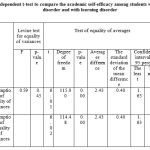 |
Table 1: Independent t-test to compare the academic self-efficacy among students without learning disorder and with learning disorder
|
Validity of the model
Since, p-value of test of Kolmogorov-Smirnov is greater than significance level 0.05, so normal assumption of observations is confirmed.
Investigating the results of the second hypothesis
There is a difference between the average of scores of self-regulation of students without learning disorder and with learning disorder.
As is seen in Table 2 p-value of test of equality of variances that is smaller than the level of (0.05) thus equal assumption of variance between two groups (without learning disorder and with learning disorder) isn’t approved. The average difference of students’ self-regulation scores with learning disorder is obtained 6.57 and standard deviations obtained 0.94. In addition to this, p- value obtained is equal to 0.00 and because is smaller than 0.05, so can reject null hypothesis and it was concluded that there is a significant difference between two groups in terms of self-regulation and the hypothesis is confirmed, so the students’ self-regulation with learning disorder is less than students without learning disorder.
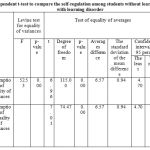 |
Table 2: Independent t-test to compare the self-regulation among students without learning disorder and with learning disorder
|
Validity of the model
Since, p-value of test of Kolmogorov-Smirnov is greater than significance level 0.05, so normal assumption of observations is confirmed.
The students ‘self-efficacy with learning disorder is less than students without learning disorder, also among male and female students, students’ self-efficacy with learning disorder are less than students without learning disorder. This means that students with learning disorders than students without learning disorders have low self-regulation. This finding is consistent with research of Alaiy Kharayem (2012) and Farrokh Hagh (2011), indicated that difference between students with learning disorders and students without learning disorder is in self-efficacy learning.
Since the self-efficacy refers to the person’s ability to deal with issues for achieving the objectives and his success and more than affected the student’s intelligence and ability to learn, affected personality traits, such as his belief, activist and not giving in
and these factors even in some students more than ability to learn cause academic achievement, since students with learning disorders often face with fail in encountering the problems and achieve goals, they submit to fail, and reduce their effort level, as a result, self-efficacy level decreases. In this regard, increase level of self-efficacy in students with learning disorders can be effective (Alaiy Kharayem, 2012).
Investigating the results of the third hypothesis
There is a difference between the average of scores of self-efficacy of students without learning disorder and with learning disorder among males.
As is seen in Table 3 p-value of test of equality of variances that is greater than the level of (0.05) thus equal assumption of variance between two groups (without learning disorder and with learning disorder) is approved. The average difference of male students’ self-efficacy scores with learning disorder is obtained 2.4 and standard deviations obtained 0.57. In addition to this, p- value obtained is equal to 0.00 and because is smaller than 0.05, so can reject null hypothesis and it was concluded that there is a significant difference between two groups in terms of self-efficacy and the hypothesis is confirmed, so the male students’ self-efficacy with learning disorder is less than male students without learning disorder.
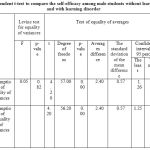 |
Table 3: Independent t-test to compare the self-efficacy among male students without learning disorder and with learning disorder
|
Validity of the model
Since, p-value of test of Kolmogorov-Smirnov is greater than significance level 0.05, so normal assumption of observations is confirmed.
Investigating the results of the fourth hypothesis
There is a difference between the average of scores of self-regulation of students without learning disorder and with learning disorder among males.
As is seen in Table 4 p-value of test of equality of variances that is smaller than the level of (0.05) thus equal assumption of variance between two groups (without learning disorder and with learning disorder) isn’t approved. The average difference of male students’ self-regulation scores with learning disorder is obtained 6.57 and standard deviations obtained 1.33. In addition to this, p- value obtained is equal to 0.00 and because is smaller than 0.05, so can reject null hypothesis and it was concluded that there is a significant difference between two groups in terms of self-regulation and the hypothesis is confirmed, so the male students’ self-regulation with learning disorder is less than students without learning disorder.
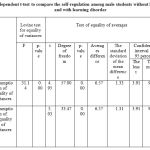 |
Table 4: Independent t-test to compare the self-regulation among male students without learning disorder and with learning disorder
|
Validity of the model
Since p-value of test of Kolmogorov-Smirnov is greater than significance level 0.05, so normal assumption of observations is confirmed.
The students’ self-regulated with learning disorder is less than students without learning disorder. As well as among male and female students, self-regulation of students with learning disorder is less than students without learning disorder. This finding is consistent with Zahed (2012) and Hashemi Nosrat Abad (2010), indicated that difference between students with learning disorder and students without learning disorder is in self-regulation learning. In this finding can be said that self-regulated learning is an important issue for human learning, successful students show learning strategies of organized self-regulation and motivational patterns when doing homework (like trying to succeed, enjoy the challenge of activity, use of learning strategies, setting specific goals and develop a high level of self-efficacy).
Investigating the results of the fifth hypothesis
There is a difference between the average of scores of self-efficacy of students without learning disorder and with learning disorder among females.
As is seen in Table 5 p-value of test of equality of variances that is greater than the level of (0.05) thus equal assumption of variance between two groups (without learning disorder and with learning disorder) is approved. The average difference of female students’ self-efficacy scores with learning disorder is obtained 2.45 and standard deviations obtained 0.57. In addition to this, p- value obtained is equal to 0.00 and because is smaller than 0.05, so can reject null hypothesis and it was concluded that there is a significant difference between two groups in terms of self-efficacy and the hypothesis is confirmed, so the female students’ self-efficacy with learning disorder is less than female students without learning disorder.
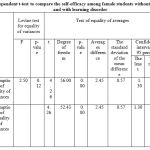 |
Table 5: Independent t-test to compare the self-efficacy among female students without learning disorder and with learning disorder
|
Validity of the model
Since, p-value of test of Kolmogorov-Smirnov is greater than significance level 0.05, so normal assumption of observations is confirmed.
Investigating the results of the sixth hypothesis
There is a difference between the average of scores of self-regulation of students without learning disorder and with learning disorder among females.
As is seen in Table 6 p-value of test of equality of variances that is smaller than the level of (0.05) thus equal assumption of variance between two groups (without learning disorder and with learning disorder) isn’t approved. The average difference of female students’ self-regulation scores with learning disorder is obtained 6.59 and standard deviations obtained 1.34. In addition to this, p- value obtained is equal to 0.00 and because is smaller than 0.05, so can reject null hypothesis and it was concluded that there is a significant difference between two groups in terms of self-regulation and the hypothesis is confirmed, so the female students’ self-regulation with learning disorder is less than female students without learning disorder.
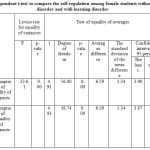 |
Table 6: Independent t-test to compare the self-regulation among female students without learning disorder and with learning disorder
|
Validity of the model
Since, p-value of test of Kolmogorov-Smirnov is greater than significance level 0.05, so normal assumption of observations is confirmed.
References
- Zahed, Adel. (2012). Comparison of social adjustment, emotional, educational and self-regulated learning in students with and without learning disabilities, Journal of Learning Disabilities, First Year, Issue 2, Spring 2012.
- Alaiy Kharayem, Roghaye (2012). Comparison of self-efficacy beliefs and achievement motivation among students with and without learning disability, Journal of Learning Disabilities, the first year, No. 3, Summer 2012.
- Farrokh Hagh, Ranjbar (2011). Comparison of self-efficacy, emotional disturbance and loneliness in students with learning disability and normal, Applied Psychology, Fifth year, Issue 2011, row 20.
- Karimzadeh, Mansoure. (2006). The relationship between academic self-efficacy and academic achievement in second grade high school girl students in Tehran, women’s studies, summer and autumn of 2006; 4 (2 (11)): 29-45.
- Keshtidar, M. (2010). Comparison of self-regulation strategies between male and female athletes in individual and team disciplines, Physical Education, Volume 6, Issue 12, Summer 2010, Pages 83-100
- Mard Ali, L. (2008). The relationship between self-regulation and academic achievement of thought and behavior (Applied Psychology (. Spring 2008; 2 (7): 49-78.
- Hashemi Nosrat Abad, T. (2010). Comparison of executive functions of emotional and motivation self-regulation in subtypes of Attention deficit hyperactivity disorder based on Barkley, news of cognitive sciences, Winter 2010; 12 (4 (48)): 67-77.
- Bembenutty, H. (2008) Self-regulation of learning and academic delay of gratification :gender and ethnic differences among college students, Journal of Advanced Academics, Vol. 18, N.4, PP. 586-616.
- Klassen, R.M. (2010). Confidence to manage learning: The self- efficacy for self- regulated learning of early adolescents with learning disabilities. Learning Disability Quarterly, 33, 19-30.
- Phillips L (2007). A comparison of general self-efficacy and drinking refusal self-efficacy in predicting drinking behavior, Am J Drug Alcohol Abuse. 2007;33(6):833-41
- Kobau R, DiIorio C (2003). Epilepsy self-management: a comparison of self-efficacy and outcome expectancy for medication adherence and lifestyle behaviors among people with epilepsy, Epilepsy Behav. 2003 Jun;4(3):217-25.








